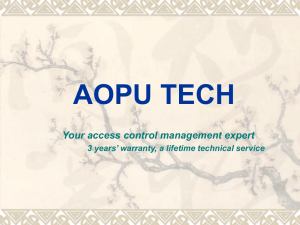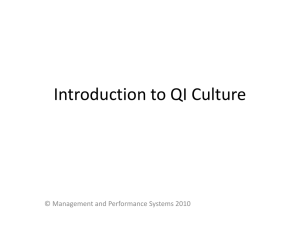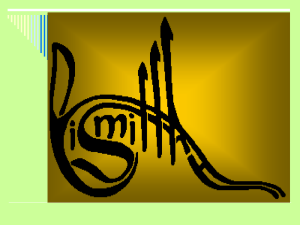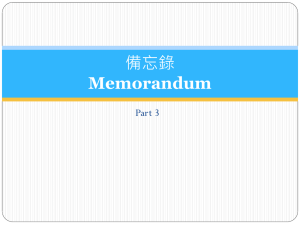presentation source
advertisement
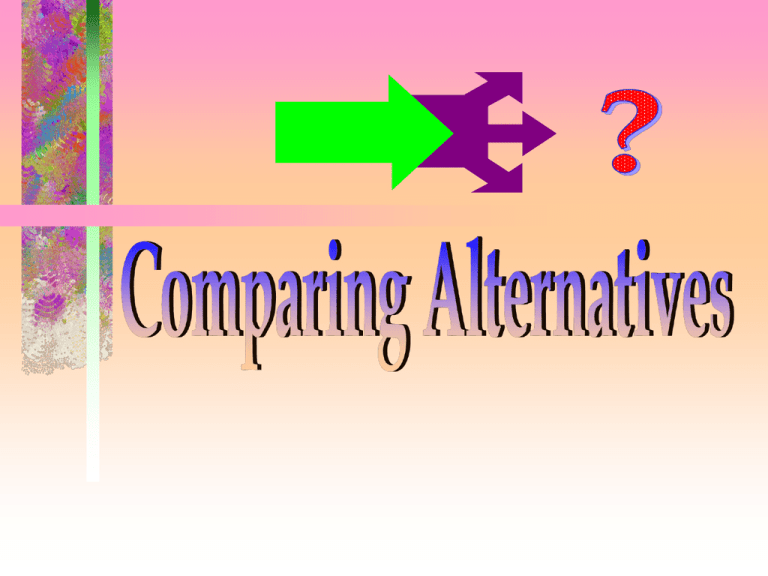
Definitions
Investment Proposal: a single undertaking
or project being considered as an
investment possibility.
– Independent Proposal: the acceptance from a
set of alternatives has no effect on the
acceptance of any other proposals in the set.
– Dependent Proposals
• Mutually exclusive proposal : the acceptance of
one proposal precludes the acceptance of any of
the others.
• Contingent proposal: the acceptance of the
proposal is dependent on the acceptance of
some prerequisite proposal.
Dr. C.J. Su IEEM Dept. HKUST
Examples
Independent Proposals - the purchase of a
CNC milling machine, a security system,
office furniture, and fork lift trucks.
Dependent Proposals
– Mutually exclusive proposal : Select a course
from a set of courses that have the same time
slot. Select different brand of equipment that
perform the same functions.
– Contingent proposal: the purchase of software
is contingent on the purchase of hardware.
The construction of the 3rd floor is contingent
on the construction of 1st & 2nd floors.
Dr. C.J. Su IEEM Dept. HKUST
Comparing Alternatives with Equal
Planning Horizon
A & B Are Mutually Exclusive
At i%= MARR
If PW(A) > PW(B) => Accept A
Else Accept B
If FW(A) > FW(B) => Accept A
Else Accept B
If AW(A) > AW(B) => Accept A
Else Accept B
Dr. C.J. Su IEEM Dept. HKUST
Example
Three mutually exclusive investment alternatives
for implementing an office automation plan in a
firm are being considered. The study period is 10
years, and the useful lives of all three alternatives
are also 10 years. Market values of all alternatives
are zero at the end of their useful lives. If the firm's
MARR is 10% /year, which alternative should be
selected ?
A
Investment
Net Revenue
Alternative
C
B
-390,000 -920,000 -660,000
69,000 167,000 133,500
Dr. C.J. Su IEEM Dept. HKUST
Solution
PW(10%)A = -$390,000 + $69,000(P/A, 10%, 10)
= $33,977
PW(10%)B = -$920,000 + $167,000(P/A, 10%, 10)
= $106,148
PW(10%)C = -$660,000 + $133,500(P/A, 10%,10)
= $160,304
C > B > A, means C is preferred to B and B is
preferred to A.
Dr. C.J. Su IEEM Dept. HKUST
IRR Method
If IRR of (A - B) > MARR => the
incremental investment is justified;
therefore proposal A should be selected
If A & B are mutually exclusive alternatives
If IRR(A - B) > MARR => Accept A, Reject B
Else Accept B and Reject A
Dr. C.J. Su IEEM Dept. HKUST
Example
Alternative
A
Capital investment - 60,000
Net Annual revenues 22,000
B
- 73,000
26,225
(B -A)
-13,000
4,225
N = 4 years, MARR = 10%
Alternative
A
B
IRR
17.3%
16.3%
PW (10%)
9,738
10,131
Dr. C.J. Su IEEM Dept. HKUST
Incremental Analysis Procedure
Arrange the alternatives on the order of
increasing capital investment
Case 1: For Investment Alternatives:
Compute the IRR for each alternatives
– If all IRR < MARR => Do nothing
– If exactly one alternative’s IRR > MARR =>
Select this alternative
– If more than one alternative’s IRR > MARR,
use incremental criterion to select the best
alternative.
Case 2: For Cost Alternatives:
Use incremental criterion to select the best alternative
Dr. C.J. Su IEEM Dept. HKUST
Investment Proposal Example
Suppose that we are analyzing the following six
mutually exclusive alternatives for a project (arranged
in ascending order of initial investment) using the IRR
method. The useful life of each alternative is 10 years,
and the MARR is 10% per year. Also, net annual
revenues less expenses vary among all alternatives. If
the study period is 10 years, and the salvage (market)
values are 0, which alternative should be chosen?
A
B
C
D
E
F
Capital investment - 900 - 1,500 - 2,500 - 4,000 - 5,000 -7,000
Annual revenues
less expenses
150
276
400
925 1,125 1,425
Dr. C.J. Su IEEM Dept. HKUST
Solution
A
B
C
IRR 10.6% 13.0% 9.6%
D
E
F
19.1% 18.3% 15.6%
Alternative C is unacceptable IRR(C) < MARR
Select A as the base for comparison
Dr. C.J. Su IEEM Dept. HKUST
Cost Proposal Example
D1
Capital investment -100,000
Annual expenses - 29,000
Useful life (years)
5
Market value
10,000
Design Alternative
D2
D3
D4
-140,600 -148,200 -122,000
- 16,900 - 14,800 - 22,100
5
5
5
14,000
25,600
14,000
Dr. C.J. Su IEEM Dept. HKUST
ERR Example
The analysis period is six years, and the MARR for capital
investments at the plant is 20% per year before taxes. Using
the ERR method, which alternative should be selected? ( =
MARR.)
| - 640,000|(F/P, i '%,6)= 262,000(F/P,20%,5) +... + 260,000 = 2,853,535
Dr. C.J. Su IEEM Dept. HKUST
Parking Lot Construction Example
Capital
Net Annual
Investment
Income
P. Keep existing parking
lot, but improve
B1. Construct one-story
building
B2. Construct two-story
building
B3. Construct three-story
building
- 200,000
22,000
- 4,000,000
600,000
- 5,550,000
720,000
- 7,500,000
960,000
MARR = 10%, N= 15 years, Salvage = Initial Investment
Dr. C.J. Su IEEM Dept. HKUST
Selection based on PW Method
PW(10%)p = -$200,000 + $22,000(P/A,10%,15) +
$200,000(P/F,10%,15) = $15,214
PW(10%)B1 = - 4,000,000 + $600,000(P/A,10%.15)
+ $4,000,000(P/F,10%,15) = $1,521,260
PW(10%)B2 = - $5,550,000 + $720,000(P/A,10%,15)
+ $5,550,000(P/F,10%,15) = $1,255,062
PW(10%)B3 = - $7,500,000 + $960,000(P/A,10%,15)
+ $7,500,000(P/F,10%,15) = $1,597,356
From PW => Select B3
Dr. C.J. Su IEEM Dept. HKUST
Selection based on IRR
Mutually Exclusive Alternatives
P
B1 - P
B2 - B1
B3 - B1
Capital
- 200,000 - 4,000,000 - 5,550,000 - 7,500,000
investment
Net annual
22,000
600,000
720,000
960,000
income
Residual
200,000 4,000,000 5,550,000 7,500,000
value
IRR
11%
15%
13%
Dr. C.J. Su IEEM Dept. HKUST
12.8%
Dr. C.J. Su IEEM Dept. HKUST
Conclusion
PW and IRR Incremental
Analysis methods reach
consistent selection for mutually
exclusive alternatives.
Whenever possible try Not to use
IRR to compare alternatives. Use
PW, FW, or AW.
Dr. C.J. Su IEEM Dept. HKUST
Comparing Alternatives
with Unequal Lives
When comparing alternatives with
unequal lives, the principle that all
alternatives under consideration
must be compared over the same
time span is basic to sound decision
making.
Dr. C.J. Su IEEM Dept. HKUST
Method 1
Estimation of Required Cash Flow
When the required cash flow (salvage
value) can be estimated, this method can
be applied.
Case 1: Alternative’s Useful life > study period
the salvage value for the alternative extending
beyond the study period must be directly
estimated.
Dr. C.J. Su IEEM Dept. HKUST
Example
EOY
0
1
2
3
4
5
Alternatives
A
-15,000
- 6,000
- 6,000
- 6,000
- 6,000
- 6,000 + 3,000
B
- 20,000
- 2,000
- 2,000
- 2,000
____
____
Dr. C.J. Su IEEM Dept. HKUST
Suppose study period (planning horizon) = 3
4,000
0
1
2
3
Estimated 3,000
4
5
A
- 6,000 /year
- 15,000
0
1
2
3
B
- 20,000
- 2,000 /year
Dr. C.J. Su IEEM Dept. HKUST
If MARR = 20%, Alternatives A & B
“coterminated” at year 3
AW (A) = -15,000 (A/P, 20%, 3) - 6,000 +
4,000(A/F, 20%, 3) = -12,021
AW(B) = -20,000(A/P, 20%, 3) - 2,000 = -11,494
=> B > A
Using PW or FW will yield the same result.
Dr. C.J. Su IEEM Dept. HKUST
Case 2: Alternative’s Useful life < study period
the operational cost and/or revenue value
for the alternative extending beyond the
study period must be directly estimated.
Assuming that the study period = 5 and at
year 4 & 5 will require costs $3,000 per
year for the last two years of alternative
B’s life.
Dr. C.J. Su IEEM Dept. HKUST
0
1
2
3
4
3,000
5
A
- 6,000 /year
- 15,000
PW (A) = -15,000 (A/P, 20%,5) - 6,000 + 3,000(A/F, 20%, 5)
= -10,613
0
1
2
3
B
- 2,000 /year
- 3,000
- 3,000
- 20,000
Estimated
PW (B) = - 20,000(A/P, 20%, 5) - 2,000 1,000(F/A, 20%, 2) (A/F, 20%, 5) = -8,984
=> B > A
Dr. C.J. Su IEEM Dept. HKUST
Method 2
For alternatives that are repeatable (long
term planning horizon). For example,
public service facility.
The repeatability assumption assuming
that the alternative will repeat identical
cash flow pattern until the common study
period is reached.
Dr. C.J. Su IEEM Dept. HKUST
Example
Two mutually exclusive investment alternatives, A and B,
associated with a small engineering project for which
revenues as well as expenses are involved. They have
useful lives of 4 and 6 years, respectively. If the MARR =
10% per year, show which feasible alternative is more
desirable by using equivalent worth methods. Use the
repeatability assumption.
A
Capital investment
- $3,500
Annual revenue
1,900
Annual expenses
- 645
Useful life (years)
4
Market value at end of useful life
0
B
- $5,000
2,500
-1,020
6
0
Dr. C.J. Su IEEM Dept. HKUST
AW(10%)A = -3,500(A/P,10%,4) + (1,900 - 645) = 151
AW(10%)B = -5,000(A/P,10%,6) + (2,500 - 1,020) = 332
B>A
Dr. C.J. Su IEEM Dept. HKUST
Consistency in AW, PW, and FW
PW(10%)A = - 3,500 - 3,500[(P/F,10%,4) + (P/F,10%,8)] +
(1,900 - 645)(P/A,10%,12) = 1,028
PW(10%)B = - 5,000 - 5,000(P/F,10%,6) + (2,500 1,020)(P/A,10%,12) = 2,262
B>A
FW(10%)A = [- 3,500(F/P,10%,4) +
(1,900 - 645)(F/A,10%,4)](F/P,10%,2) = 847
FW(10%)B = - 5,000(F/P,10%,6) +
(2,500 - 1,020) (F/A,10%,6) = 2,561
B>A
Dr. C.J. Su IEEM Dept. HKUST
Pump Model
SP240
HEPS9
Capital investment
- 33,200
Annual expenses:
Electrical energy
- 2,165
Maintenance
- 1,100 in year 1,
and increasing
-500/yr thereafter
Useful life (years)
5
Salvage value
0
- 47,600
- 1,720
- 500 in year 4, and increasing
- 100/yr thereafter
9
5,000
The new processing facility is needed by your firm at least as far into the
future as the strategic plan forecasts operating requirements. The MARR,
before taxes, is 20% per year. Based on this information, which model
slurry pump should you select?
Dr. C.J. Su IEEM Dept. HKUST
With the repeatability assumption
AW(20%)Sp240 = - 33,200(A/P,20%,5) - 2,165
- [1,100 + 500(A/G,20%,5)] = -15,187
AW(20%)HEPS9 = - 47,600(A/P,20%,9) + 5,000(A/F,20%,9)
- 1,720 - [500(P/A,20%,6) + 100(P/G,20%,6)] x
(P/F,20%,3) x (A/P,20%,9) = - 13,622
HEPS9 > SP240
Dr. C.J. Su IEEM Dept. HKUST
Suppose that the estimated market value of pump model
HEPS9 in five years is $15,000, and the firm's MARR
remains 20% per year. Which pump model should be
selected for this replacement action?
AW(20%)HEPS9 = - 47,600(A/P,20%,5) +
15,000(A/F,20%,5) - 1,720
- [$500(P/F,20%,4) + $600(P/F,20%,5)] x
(A/P,20%,5) = - 15,783
AW(20%)SP240 = - 15,187 (from previous example)
SP240 > HEPS9
Dr. C.J. Su IEEM Dept. HKUST
Imputed (Implied) Market
Value Technique
When study period T < Useful Life
This technique estimates the value of the
remaining life for an asset
The market value of an asset at time T, MVT
MVT = [EW at end of year T of remaining capital
recovery amounts] + [EW at end of year T of original
market value at end of useful life]
where EW means equivalent worth at i = MARR.
Dr. C.J. Su IEEM Dept. HKUST
Example
Suppose that the pump example is modified such
that another market value for pump model
HEPS9, at the end of year five, is developed using
the imputed market value technique. The same
question is again asked, which pump model
(SP240 or HEPS9) should be selected for
replacement of the current pump in the catalytic
system? The MARR remains 20% per year and the
study period remains five years.
Dr. C.J. Su IEEM Dept. HKUST
EWCR = [47,600(A/P,20%,9) - 5,000(A/F,20%,9)] x
(P/A,20%,4) = 29,949
Compute the EW at end of year five, based on the
original MV at end of useful life:
EWMV = 5,000(P/F,20%,4) = 2,412
Then, the new market value estimate at the end of
year five is as follows:
MVs = EWCR + EWMV = 29,949 + 2,412 = 32,361
AW(20%)HEPS9 = - 47,600(A/P,20%,5) + 32,361
(A/F,20%,5) - 1,720 - [$500(P/F,20%,4) +
600(P/F,20%,5)]x (A/P,20%,5) = -13,449
AW(20%)SP240 = -15,187,
=> pump model HEPS9 > SP240
Dr. C.J. Su IEEM Dept. HKUST
Capitalized Worth (CW) Method
CW method involves in determining the present
worth of all revenues and/or expenses over an
infinite length of time (e.g., charity fund,
scholarship, scientific foundation, etc.).
Suppose the end of period uniform payment = A
CW = PWN-> = A(A/P, i%, N)
= A {limN-> [(1+ i)N - 1]/[i [(1+ i)N]} = A/i
=> P * i = A = P(A/P, i, N) => i = (A/P, i, N)
Dr. C.J. Su IEEM Dept. HKUST
Example
A firm wishes to endow an advanced manufacturing processes
laboratory at a university. The endowment principal will earn
interest that averages 8% per year, which will be sufficient to
cover all expenditures incurred in the establishment and
maintenance of the laboratory for an indefinitely long period
of time (forever). Cash requirements of the laboratory are
estimated to be $100,000 now (to establish it), $30,000 per
year indefinitely, and $20,000 at the end of every fourth year
(forever) for equipment replacement.
(a) For this type of problem, what study period (N) is, practically
speaking, defined to be "forever"?
(b) What amount of endowment principal is required to establish
the laboratory and then earn enough interest to support the
remaining cash requirements of this laboratory forever?
Dr. C.J. Su IEEM Dept. HKUST
(a)
As N-> , i = (A/P, i, N)
For i = 8% , (A/P,8%,N) = 0.08 = i when N = 100.
=> N = 100 is essentially forever
(b)
CW = - 100,000 - [30,000 + $20,000(A/F,8%,4)] / 0.08
= -$530,475
Dr. C.J. Su IEEM Dept. HKUST
A scholarship offers a student $15,000 a
month. What’s the deposit required if the
bank’s annual interest rate is 12% nominal.
i= 12% / 12 = 1%
CW = A / i = 15,000 / 0.01 = 1,500,000
Dr. C.J. Su IEEM Dept. HKUST
Example
A selection is to be made between two structural
designs. Because revenues do not exist (or can be
assumed to be equal), only negative cash flow
amounts (costs) and the market value at the end of
useful life are estimated, as follows:
Structure M Structure N
Capital investment
- $12,000
- $40,000
Market value
0
10,000
Annual expenses
- 2,200
- 1,000
Useful life (years)
10
25
Using the repeatability assumption and the CW method
of analysis, determine which structure is better if the
MARR is 15% per year.
Dr. C.J. Su IEEM Dept. HKUST
AW(15%)M = -12,000(A/P,15%,10) - 2,200
= - 4,592
AW(15%)N = - 40,000(A/P,15%,25)
+ 10,000(A/F,15%,25)
- 1,000 = - 7,141
CW(15%)M = AWM / i = - 4,592 / 0.15 = - 30,613
CW(15%)N = AWN / i = -7,141 / 0.15 = - 47,607
M>N
Dr. C.J. Su IEEM Dept. HKUST
Forming
mutually exclusive Alternatives
– Independent Proposal: the acceptance from a
set of alternatives has no effect on the
acceptance of any other proposals in the set.
– Dependent Proposals
• Mutually exclusive proposal : the acceptance
of one proposal precludes the acceptance of
any of the others.
• Contingent proposal: the acceptance of the
proposal is dependent on the acceptance of
some prerequisite proposal.
Dr. C.J. Su IEEM Dept. HKUST
If Xj = 1 => Accept Xj
Xj = 0 => Reject Xj
For three mutually exclusive projects, the
alternatives are:
Dr. C.J. Su IEEM Dept. HKUST
If there are k independent proposals, then there
are 2k possible selections of alternatives.
Dr. C.J. Su IEEM Dept. HKUST
A company is considering two independent sets of
mutually exclusive projects. That is, projects A1 and A2
are mutually exclusive, as are B1 and B2. However, the
selection of any project from the set of projects A1 and
A2 is independent of the selection of any project from
the set of projects B1 and B2
Dr. C.J. Su IEEM Dept. HKUST
Five proposed projects are being considered. B1 and B2
are independent of C1 and C2. Also, certain projects
are dependent on others that may be included in the
final portfolio. Using the PW method and MARR =
10% per year, determine what combination of projects
is best if the capital to be invested is (a) unlimited, and
(b) limited to $48,000.
Project B1 & B2 mutually exclusive and independent of
C set
Project C1 & C2 mutually exclusive and dependent
(contingent) on the acceptance of B2
Project D contingent on the acceptance of C1
Dr. C.J. Su IEEM Dept. HKUST
Dr. C.J. Su IEEM Dept. HKUST
(a) Alternative 6 is the best
(b) Alternatives 2 & 6 are excluded due to the
budget limit $48,000 => alternative 5 is the
best
Dr. C.J. Su IEEM Dept. HKUST

